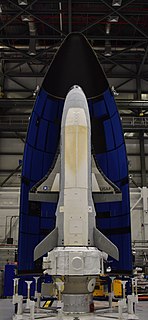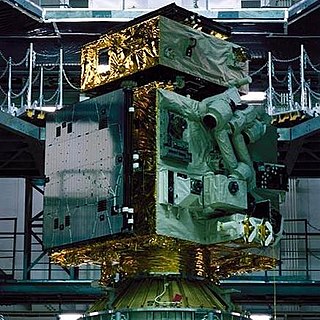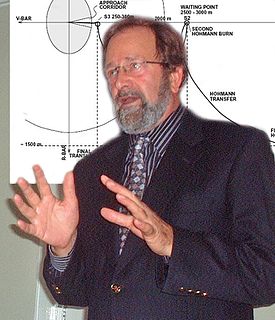
The George C. Marshall Space Flight Center (MSFC), located in Redstone Arsenal, Alabama, is the U.S. government's civilian rocketry and spacecraft propulsion research center. As the largest NASA center, MSFC's first mission was developing the Saturn launch vehicles for the Apollo program. Marshall has been the lead center for the Space Shuttle main propulsion and external tank; payloads and related crew training; International Space Station (ISS) design and assembly; computers, networks, and information management; and the Space Launch System (SLS). Located on the Redstone Arsenal near Huntsville, MSFC is named in honor of General of the Army George C. Marshall.

The Automated Transfer Vehicle, originally Ariane Transfer Vehicle or ATV, was an expendable cargo spacecraft developed by the European Space Agency (ESA), used for space cargo transport in 2008–2015. The ATV design was launched to orbit five times, exclusively by the Ariane 5 heavy-lift launch vehicle. It effectively was a larger European counterpart to the Russian Progress cargo spacecraft for carrying upmass to a single destination—the International Space Station (ISS)—but with three times the capacity.

SSL, formerly Space Systems/Loral, LLC (SS/L), of Palo Alto, California, is a wholly owned manufacturing subsidiary of Maxar Technologies.

STS-96 was a Space Shuttle mission to the International Space Station (ISS) flown by Space Shuttle Discovery, and the first shuttle flight to dock at the International Space Station. The shuttle carried the Spacehab module in the payload, filled with cargo for station outfitting. STS-96 launched from Kennedy Space Center, Florida, on 27 May 1999 at 06:49:42 AM EDT and returned to Kennedy on 6 June 1999, 2:02:43 AM EDT.

A space rendezvous is a set of orbital maneuvers during which two spacecraft, one of which is often a space station, arrive at the same orbit and approach to a very close distance. Rendezvous requires a precise match of the orbital velocities and position vectors of the two spacecraft, allowing them to remain at a constant distance through orbital station-keeping. Rendezvous may or may not be followed by docking or berthing, procedures which bring the spacecraft into physical contact and create a link between them.

The Boeing X-37, also known as the Orbital Test Vehicle (OTV), is a reusable robotic spacecraft. It is boosted into space by a launch vehicle, then re-enters Earth's atmosphere and lands as a spaceplane. The X-37 is operated by the United States Space Force for orbital spaceflight missions intended to demonstrate reusable space technologies. It is a 120-percent-scaled derivative of the earlier Boeing X-40. The X-37 began as a NASA project in 1999, before being transferred to the United States Department of Defense in 2004. Until 2019, the program was managed by Air Force Space Command.

DART, or Demonstration for Autonomous Rendezvous Technology, was a NASA spacecraft with the goal to develop and demonstrate an automated navigation and rendezvous capability. At the time of the DART mission, only the Roscosmos and JAXA had autonomous spacecraft navigation. Orbital Sciences Corporation (OSC) was the prime contractor for construction, launch and operation of the DART spacecraft with a project cost of US$110 million (2005). The contract was awarded in June 2001 and the spacecraft was launched on 15 April 2005. The mission ended prematurely, very shortly after an anomalous slow-velocity collision with its target spacecraft, having completed less than half of the original mission autonomous rendezvous objectives.
Autonomous Space Transport Robotic Operations (ASTRO), is an American technology demonstration satellite which was operated as part of the Orbital Express program. It was used to demonstrate autonomous servicing and refuelling operations in orbit, performing tests on the NEXTSat satellite which was launched with ASTRO for that purpose. Launched in March 2007, it was operated for four months, and then deactivated in orbit.
NEXTSat, or Next Generation Satellite and Commodities Spacecraft (NEXTSat/CSC) is an American technology demonstration satellite which was operated as part of the Orbital Express programme. It was used as a target spacecraft for a demonstration of autonomous servicing and refueling operations performed by the ASTRO satellite. Launched in March 2007, it was operated for four months, and then deactivated in orbit.

The ETS-VII, or Engineering Test Satellite No. 7, was a satellite developed and launched by the National Space Development Agency of Japan (NASDA). It is also known as KIKU-7. It was launched aboard an H-II rocket from Tanegashima Space Center, on 28 November 1997. The ETS-VII was equipped with a 2-meter-long (6.6 ft) robotic arm, which was used to carry out several experiments related to rendezvous docking and space robotics. It was the world's first satellite to be equipped with a robotic arm, and also Japan's first uncrewed spacecraft to conduct autonomous rendezvous and docking operations successfully, decades after the docking of the Soviet Kosmos 186 and Kosmos 188 spacecraft in 1967. Although it was originally intended to be used for 1.5 years, the satellite was functional for a period of almost five years. ETS-VII eventually decayed from orbit on 13 November 2015.

Wigbert Fehse is a German engineer and researcher in the area of automatic space navigation, guidance, control and docking/berthing.

An orbital propellant depot is a cache of propellant that is placed in orbit around Earth or another body to allow spacecraft or the transfer stage of the spacecraft to be fueled in space. It is one of the types of space resource depots that have been proposed for enabling infrastructure-based space exploration. Many different depot concepts exist depending on the type of fuel to be supplied, location, or type of depot which may also include a propellant tanker that delivers a single load to a spacecraft at a specified orbital location and then departs. In-space fuel depots are not necessarily located near or at a space station.
TriDAR, or Triangulation and LIDAR Automated Rendezvous and Docking, is a relative navigation vision system developed by Neptec Design Group and funded by the Canadian Space Agency and NASA. It provides guidance information that can be used to guide an unmanned vehicle during rendezvous and docking operations in space. TriDAR does not rely on any reference markers positioned on the target spacecraft. Instead, TriDAR relies on a laser based 3D sensor and a thermal imager. TriDAR's proprietary software uses the geometric information contained in successive 3D images to match against the known shape of the target object and calculate its position and orientation.

Docking and berthing of spacecraft is the joining of two space vehicles. This connection can be temporary, or partially permanent such as for space station modules.
Space Infrastructure Servicing (SIS) is a spacecraft concept being developed by Canadian aerospace firm MDA to operate as a small-scale in-space refueling depot for communication satellites in geosynchronous orbit.
A Mission Extension Vehicle (MEV) is a type of spacecraft designed to extend the functional lifetime of another spacecraft through on-orbit satellite servicing. They are 2010s-design small-scale in-space satellite-refueling spacecraft first launched in 2019. The MEV spacecraft grew out of a concept proposed in 2011 by ViviSat, a 50/50 joint venture of aerospace firms US Space and Alliant Techsystems (ATK). The joint venture was created in 2010 for the purpose of designing, producing and operating the MEV program.
On-orbit satellite servicing refers to refueling or repairing space satellites while in orbit.
The DARPA XS-1 was an experimental spaceplane/booster with the planned capability to deliver small satellites into orbit for the U.S. Military. It was reported to be designed to be reusable as frequently as once a day, with a stated goal of doing so for 10 days straight. The XS-1 was intended to directly replace the first stage of a multistage rocket by taking off vertically and flying to hypersonic speed and high suborbital altitude, enabling one or more expendable upper stages to separate and deploy a payload into low Earth orbit. The XS-1 would then return to Earth, where it could ostensibly be serviced fast enough to repeat the process at least once every 24 hours.

The Boeing Starliner Orbital Flight Test was the first orbital mission of the CST-100 Starliner spacecraft, conducted by Boeing as part of NASA's Commercial Crew Program. The mission was planned to be an eight-day test flight of the spacecraft, involving a rendezvous and docking with the International Space Station (ISS), and a landing in the western United States. The mission was launched on 20 December 2019 at 11:36:43 UTC or 06:36:43 AM EST; however an issue with the spacecraft's Mission Elapsed Time (MET) clock occurred 31 minutes into flight. This anomaly caused the spacecraft to burn into an incorrect orbit, preventing a rendezvous with the International Space Station (ISS). The mission was reduced to just two days, with the spacecraft successfully landing at White Sands Space Harbor on 22 December 2019.
SPADEX or Space Docking Experiment is a twin spacecraft mission being developed by Indian Space Research Organisation to mature technologies related to orbital rendezvous, docking, formation flying, with scope of applications in human spaceflight, in-space satellite servicing and other proximity operations.














